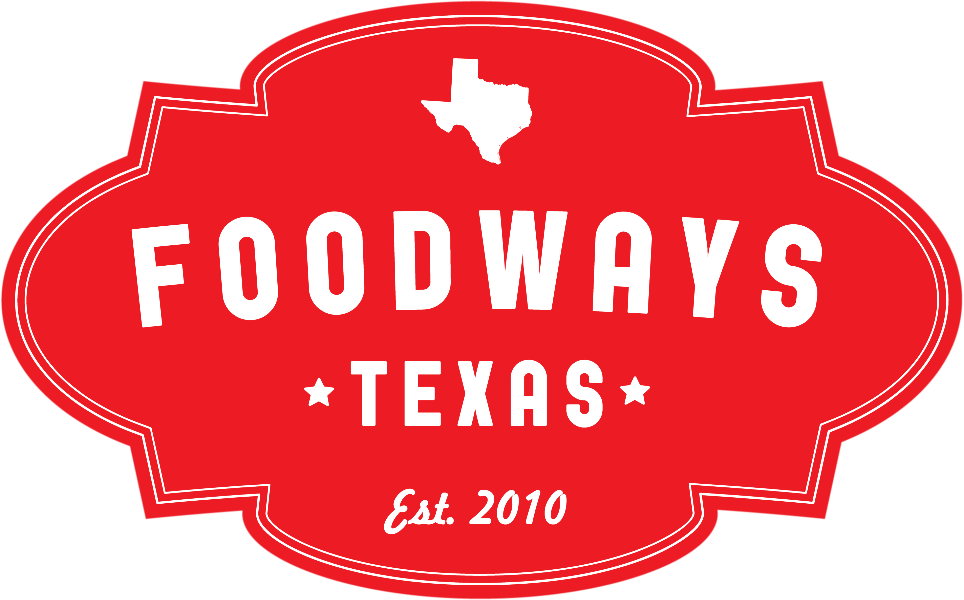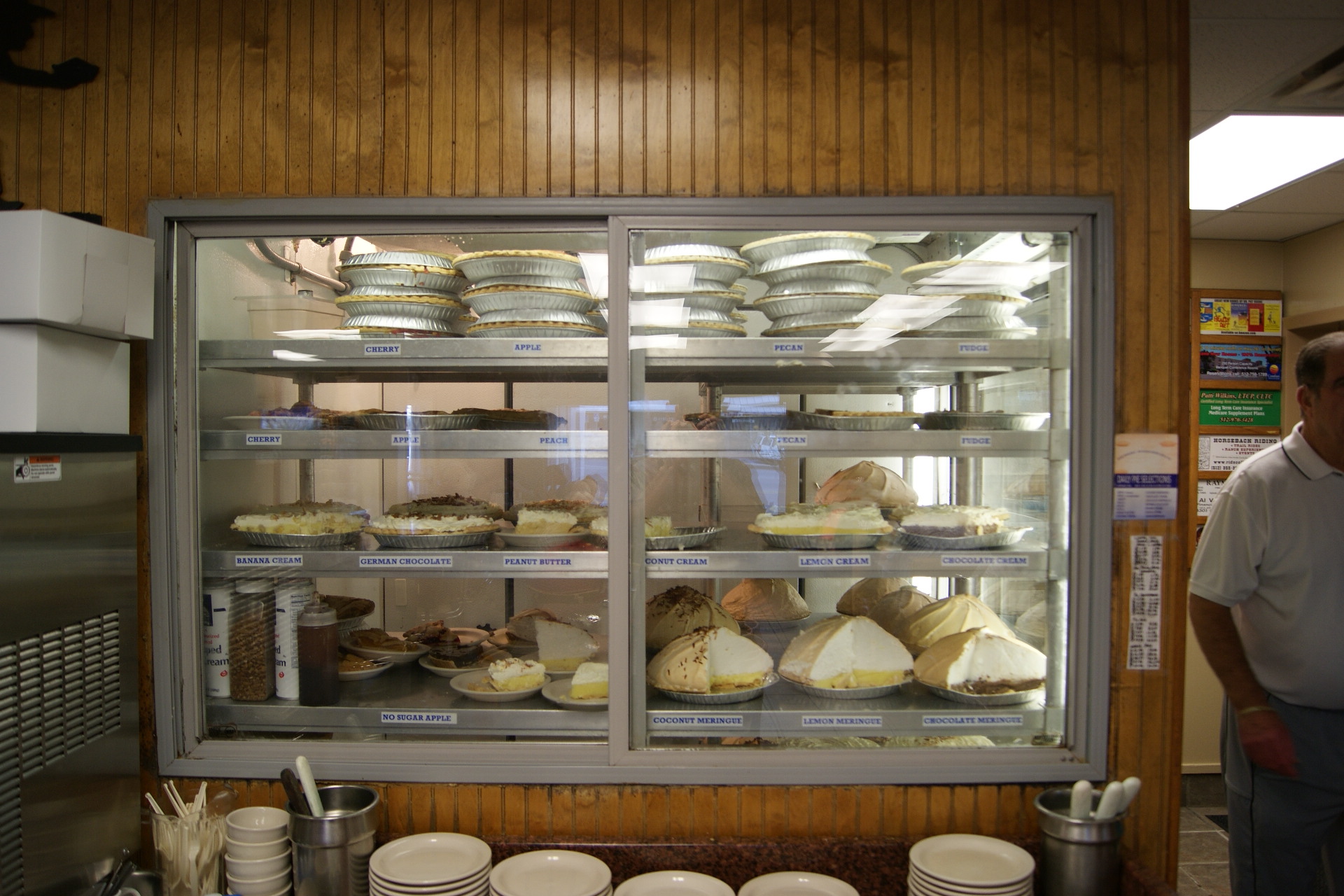Interviewer: Jennifer Doane, Nicholas Roland, and Kathryn Sutton
Location: 211 US Highway 281
This interview for the Texas Iconic Restaurant Oral History project was produced in collaboration with the Department of American Studies at the University of Texas, Austin, and the Texas Restaurant Association.
This Marble Falls landmark originally opened on Main Street in 1929, and was moved to its current location on Highway 281 in 1946. Upon relocating, the restaurant failed once and changed ownership four times before John and Belinda Kemper bought it in 1981.
The restaurant is widely known for its pies and southern comfort food. Although Blue Bonnet Cafe has undergone a few updates since the Kempers began running it, careful measures have been taken to preserve its Texas cafe mystique.
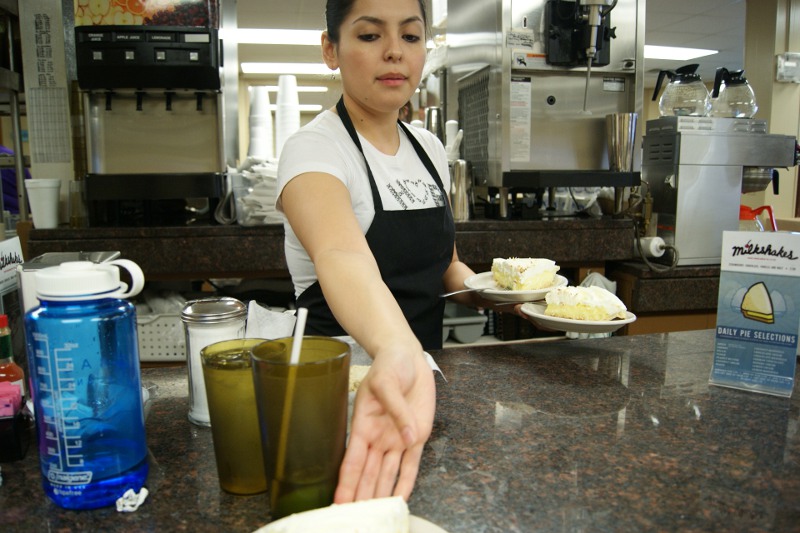
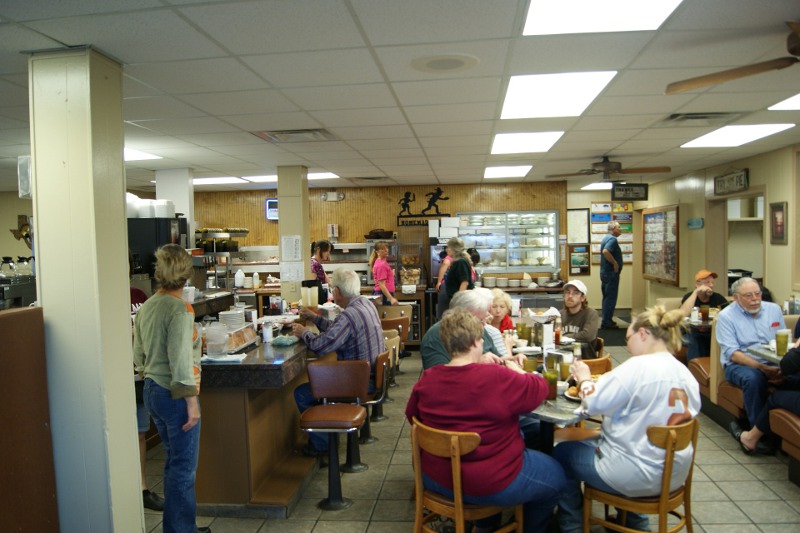

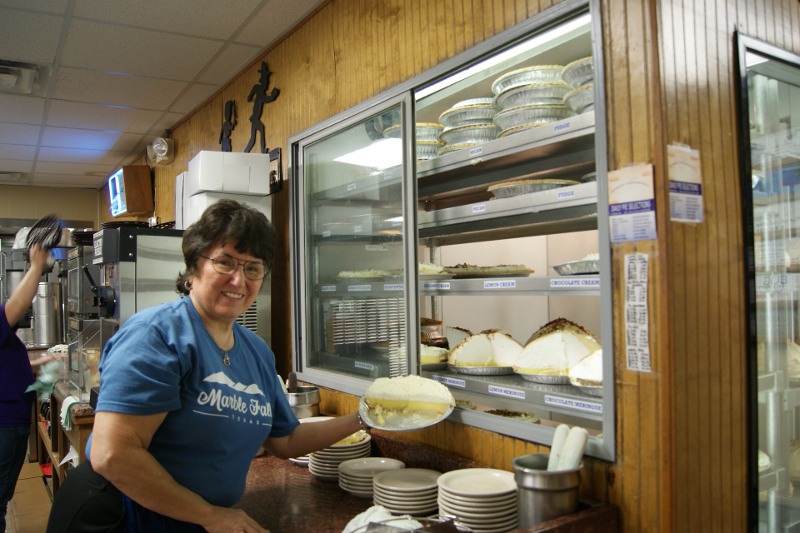
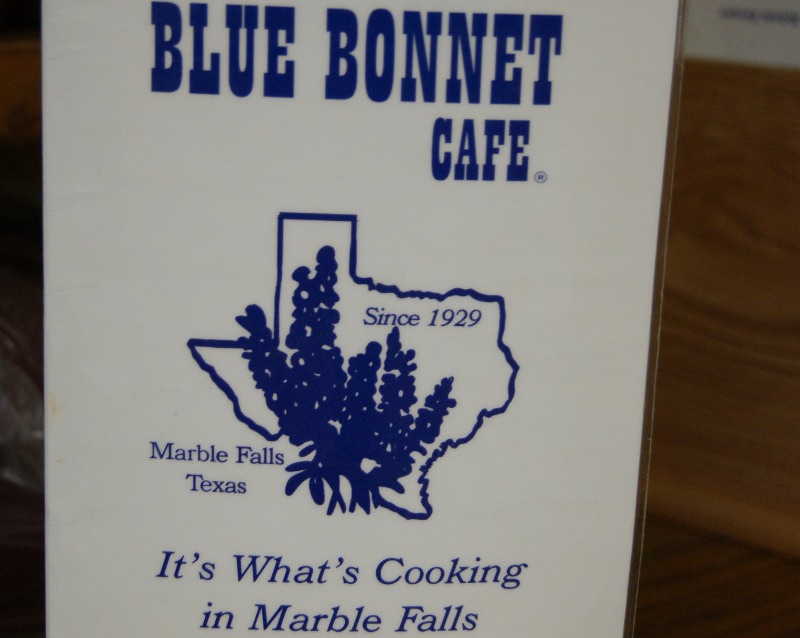

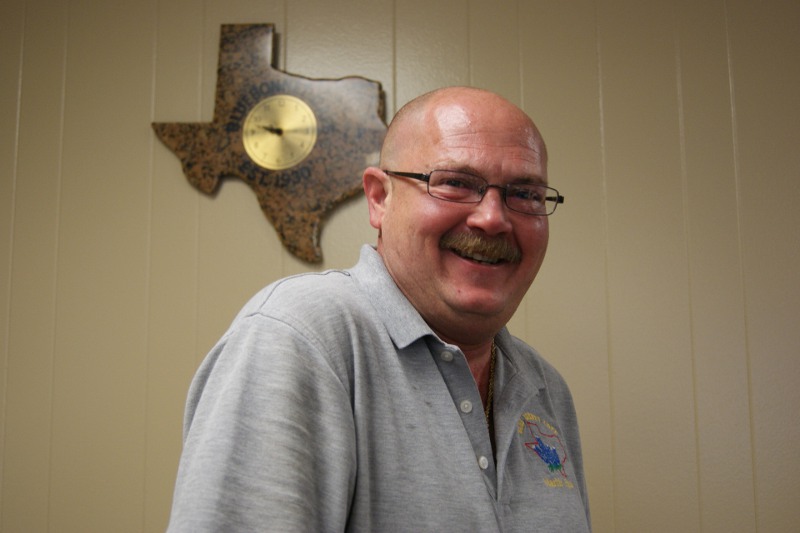



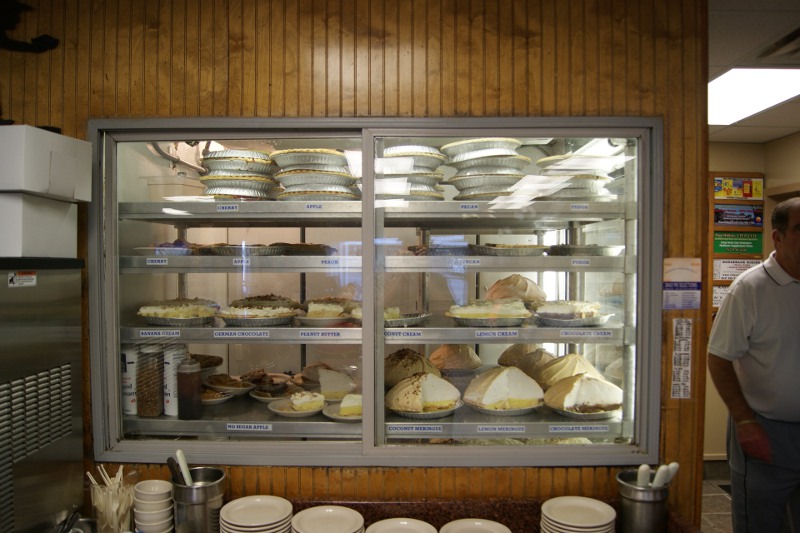
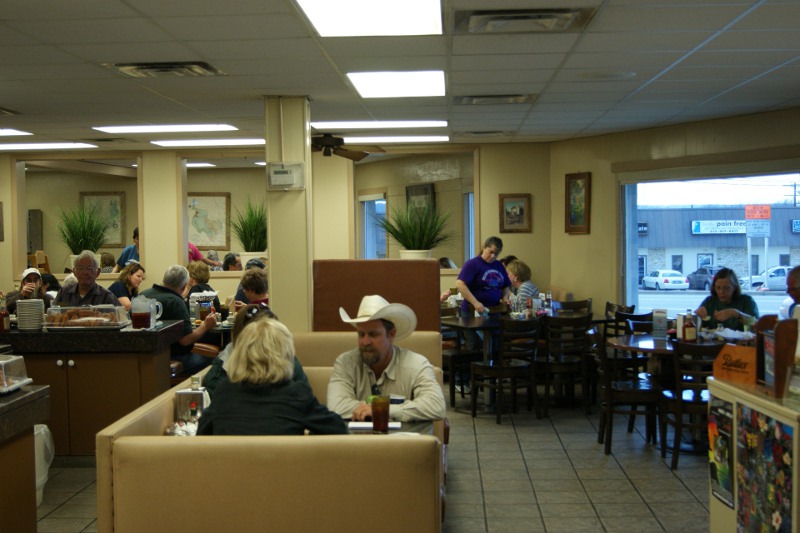

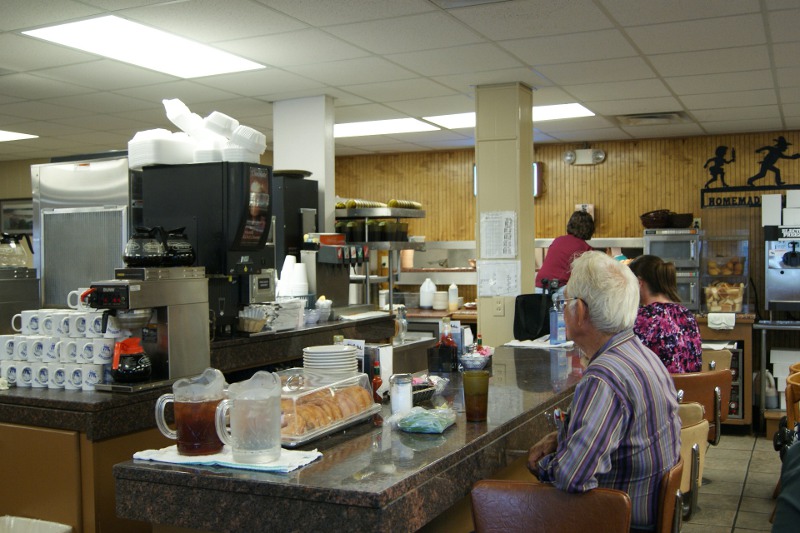
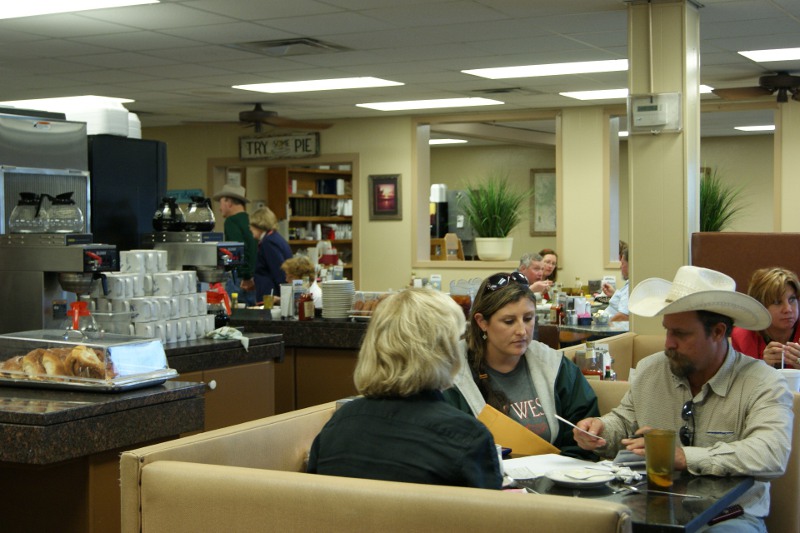
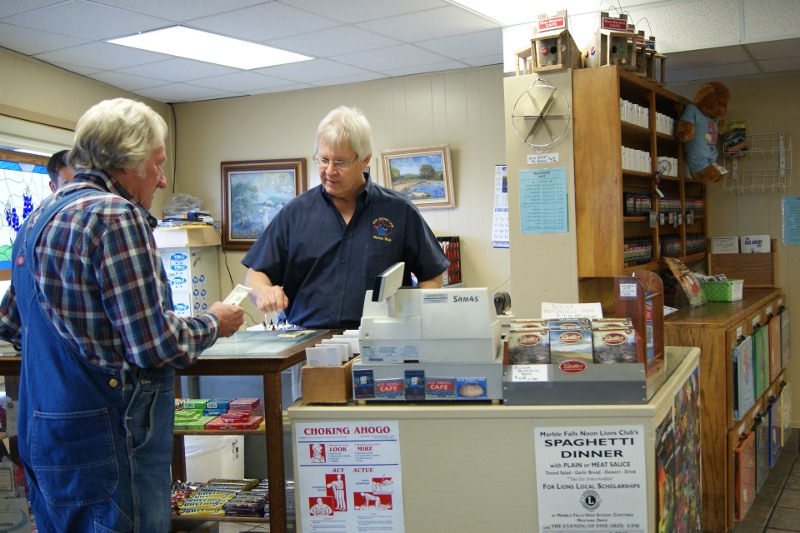
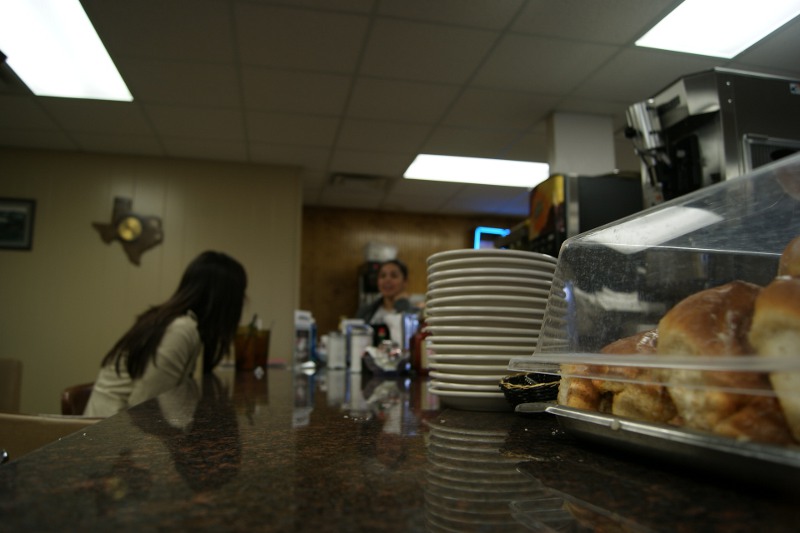
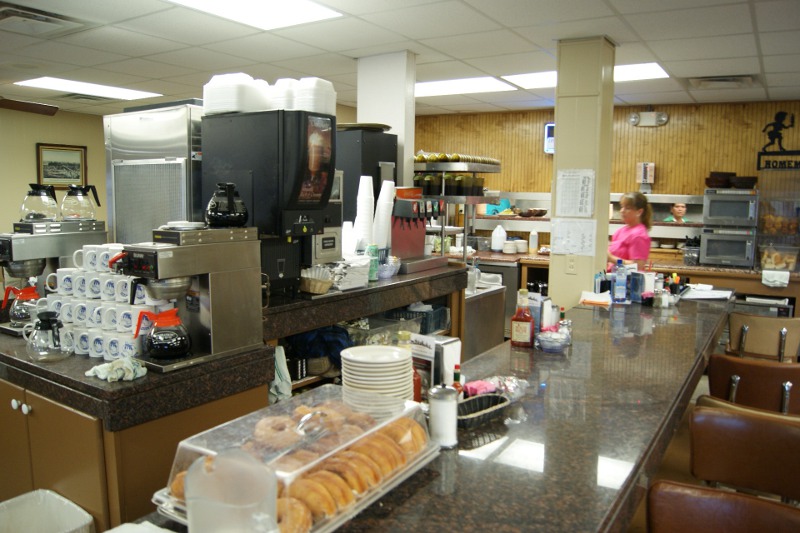
Nicholas Roland: OK, we are recording. I am Nick Roland, I am here at the Blue Bonnet Café in Marble Falls, Texas. We are sitting off in a side room of the restaurant in the middle of the afternoon, kind of a slow time, I guess, and I’m sitting here with John Kemper, the owner. So, John, if you could just tell me a little bit about yourself, uh, where you’re from, family background, and so forth.
John Kemper: Ok, well I’m John Kemper, I was born in Wichita, Kansas. I’m the son of a Air Force officer and I moved around as a military brat for years. I actually spent the fourth grade in Marble Falls, and I moved away and came back in eighth grade, and graduated from Marble Falls High School. And then went on to the University of Texas, and in 1973 I quit the University of Texas to buy my first restaurant.
NR: Could you just tell us a little bit about how that came about, how you decided to not continue with school and to get into the restaurant business?
JK: My wife and, and I, Belinda, we came home from university, and we were married—we were married when we were nineteen. We came home to spend a weekend, and, and when I was getting ready to leave that Sunday evening to go back, my dad told me that Ralph—who was the chairman of the board and owner of Home State Bank—wanted him to take over Cottonwood Resort. And Cottonwood Resort was an old resort that was out on Lake LBJ that was built in the early fifties, and this was 1973, so it had become pretty well run down, the restaurant was closed down, and he was getting ready to foreclose on it, and my dad told me that Ralph had approached him about coming and running that resort until he was able to—the bank—sell it. And I told my dad, I said, “Well I want Cottonwood.” He said, “Well you want Cottonwood?” I said, “Yeah, I, I’d like to do that.” He said, “Well, let me talk to Ralph tomorrow and I’ll give you a call tomorrow evening.” Well, about six o’clock the next evening, my dad called me up and said, “Well, you and Belinda want Cottonwood?” I said, “Yeah, we, we want Cottonwood.” He said, “Well, quit school and move back home, and I’m gonna loan you three thousand dollars and you’re gonna be in business.” And that’s how I got in the restaurant business.
NR: So, uh, given the fact that you had contacted your dad, was your dad in the restaurant business, or what, what was his background?
JK: No, my dad was a retired military officer, and then after he retired in 1967, he was pretty much a kind of an entrepreneur. And I grew up working with my dad, he, he sold mobile home, moved mobile homes, had a, had a dirt hauling business, and did several other ventures. So, that’s why the banker approached him. He knew that dad would probably go out there and do a good job for him, and uh, and I had worked with dad all those years, so, that’s kind of how that all came about. No, he had never been in the food business. But after we purchased the business, he actually came out and would make pies, and mother would help us, and the whole family pitched in to help these two nineteen year old kids try to learn how to run a restaurant.
NR: And so did you personally have any experience with the restaurant business before you, kind of, jumped into it?
JK: Uh, I actually did, when I was a sophomore at the university I went to work for Jack-in-the-Box out on Burnet Road, and I worked for about three months and I absolutely hated it, just couldn’t stand it, and I could remember writing love letters to Belinda, she was at Southwest Texas. I—when it was real slow late at night—I’d write her love letters on the hamburger wrap, and mail them to her so [Laughs]. I, I guess it didn’t sink in that the food business wasn’t for me.
NR: So you started at the Cottonwood and then came to the Blue Bonnet, can you tell us how that came about?
[00:04:00]
JK: Well what really happened was, we lived on the—actually lived on the property of Cottonwood. And the Cottonwood Resort was a restaurant with forty motel units. It was a marina, boat rental, minnow sales, bait sales, and a restaurant and, we did everything. We lived on the property, worked seven days a week, started at six in the morning, worked ‘til ten at night. We closed the restaurant on Wednesday afternoon at two, and that would be our time off. Well, we did that four years. And you’ve heard that story about Willie Nelson, how he got beat up by his wife in the middle of the night, she rolled him up in the bed and beat him with a baseball bat? Well, for about two years of my marriage there at the Cottonwood, I was afraid I was gonna have that same thing happen to me. So after four years of it, Belinda and I decided—we sold it, and—I actually pawned it off on my brother. And he bought if from us, and Belinda and I went to Europe for three months, and Eurorailed Europe, just to kind of decompress. And so we came back and I had an uncle who was wanting to build a concrete, tilt wall, solar home. So I said, “Well, I want to help you do that.” So, I went to ACC [Austin Community College] and learned how to weld and took some carpentry courses. I left there and then I went and worked for a company called Featherlite, which was over off Manor Road in East Austin, by Airport [Boulevard], and learned how to do tilt wall construction. So I did that for about four months, and then I left there and then came and worked with my uncle, and built his house. And then I built a house out on seventeen acres in the country that was all tilt wall. And about half way through the construction of that home, I thought I was gonna have a nervous breakdown… And, uh, about half way through it, standing this concrete up with the wrong kind of equipment just almost got me. But we got it built and I had a guy come, a carpenter come and he helped me finish it…And we built that house, and this was seventeen mile—seventeen acres—five miles out on a dirt road, you had to open two gates to get to it. Well, I had decided then that I didn’t think I really wanted to be a home builder, so I decided maybe I needed to get back into the food business. So I went and hired on with Wendy’s in Austin. And I started. First day I walked into a Wendy’s I swept the floor, and mopped and washed the dishes, went through the trainee program. Well I did that for about a year and a half, and I got the itch to have my own restaurant. So there was a restaurant up on Lake Buchanan called the Observation Restaurant, and I went up and hired on as a cook there with the intention of buying that business because, the owner, uh, was wanting to retire. So I went up there and hired on and what’s really interesting, today, as we do this interview, that man—that restaurateur—he’s ninety-seven years old, still living. His son came in here, to the Blue Bonnet and we visited all about those times and his dad and that restaurant. So I decided though that that wasn’t the restaurant for me, and I quit him, I went back to Wendy’s and ended up being a supervisor. And so I was living in Marble Falls, and working sixty hours a week, driving twelve hours a week back and forth, and that’s what I was doing. Well then, I actually decided, that’s crazy, I better move to Austin. So I moved my wife Belinda and my oldest daughter Lindsey and we moved to North Austin, and I worked for another year or so at Wendy’s, and then decided I needed to work back in Marble Falls. So then I went to work for the Meadow Lakes Country Club as their club manager and actually drove from Austin to Marble Falls [Laughs] and did the reverse. Well, I’d always come in the Blue Bonnet and eat breakfast and the man, Don Bridges, who’d owned the Blue Bonnet for thirteen years before me—I had known him from my old Cottonwood days. And if I’d run out of something, a case of fish or something like that, I’d get it from him or he’d borrow it from me. So I’d come in the Blue Bonnet, in the morning before I went to the Country Club, and he’d always say “John, I want to sell you the Blue Bonnet.” Well, Belinda had made me promise that I would not buy another restaurant after her experience, and our experience, at the Cottonwood. So after he begged and made me such a deal I didn’t think I could refuse I finally convinced Belinda to let me go back and buy the Blue Bonnet and she wouldn’t have to be in there working every day like I made her work at, at the Cottonwood. And that’s how we started. It was February 16, 1981, I bought the Blue Bonnet Café and I’ve been here ever since.
[00:08:49]
NR: And, when you bought it was it just kind of a turn-key operation, you just came in and started running it, or did y’all, uh, make some changes from the previous owner?
JK: Well, it, it never closed, uh yeah, the Blue Bonnet used to close at seven o’clock at night, we kept it open later. I’ve actually got some employees here still here that came with the Blue Bonnet, just a couple of them. The—we just basically—Don was tired and burned out. He actually started his restaurant career on Main Street in Marble Falls in front of the original Blue Bonnet. He was twelve years old and he was selling popcorn and the owner of the Blue Bonnet came out on the street and said, “Boy, you need a job?” And he said, “Well I’m selling popcorn.” And he said, “Well I need somebody to wait tables. Why don’t you come here and wait tables?” And he went in the Blue Bonnet and waited tables. That’s how he got started. And so he, uh, wanted to get out and that’s basically how I got into the Blue Bonnet.
NR: Well, you mention the, the long term staff that you’ve had here and it seems to be, uh, a feature of the restaurant and one that’s well known is the fact that you’ve got staff that have been here for quite a while, so how long would you say the average staff has been here?
JK: Our, our average tenure on staff is probably nine years. Our—we’ve got sixty-five employees. I’ve got at least two employees that have been here over thirty years and lots [emphasizes] in the twenties. Last year, out of sixty-five employees we only had to mail out six W-2’s. And that—and some of those people, actually one of them died so, you know, they couldn’t come in to pick it up. But most of our W-2’s were given to the employees on their paychecks, which is very, very unusual in the food business. And that’s the key to the Blue Bonnet, it’s—we’re all about our employees. We’re only as good as they are, and we’re so good because they are.
NR: And what do you think exactly is it that, that keeps people working here and wanting to work here and, and families tend to, to work here. Multiple people in a family it seems like will hold different positions here, what do you think it is that keeps people working here like that?
JK: Well, uh, the Blue Bonnet, it—it’s just like a big family here. Everybody takes care of each other, we have a lot of Hispanics here that have family members here, and, uh, we all just take care of each other. They care about each other—us as employers, we offer employees health insurance, good [emphasizes] health insurance. They have a retirement program; they get free food; they, uh, when they’re working, they have vacation time. We close the week between Christmas and New Year’s—that was so a lot of the help from Mexico could go home, which is real important. So we try to work on regular set weekly schedules where they can plan their life and get the schedule to where it works for them, not just for the Blue Bonnet, and all those things in combination make it a great place to work. And, and they want—they can stay here.
NR: Yeah, we spoke with some of the employees earlier and they echoed those sentiments about the benefits and just feeling like it was a family atmosphere and everyone kind of enjoyed working here together. Did you always have those management practices, or is that something you kind of had to come up with on the fly or something that evolved over the years?
JK: Oh, it evolved over the years. We’ve had a retirement program for probably twenty years. We’ve offered health insurance to our employees, well it—when Hillary Clinton and Bill Clinton were in office and Hillary was trying to get her healthcare passed, uh, I wasn’t real, a real supporter of that and I decided I wasn’t going to have the government tell me when I had to give my employees insurance so I went ahead and did it on our own and that’s kind of how that came about, but a lot of those things people can’t do in the food business. It’s, it’s, it’s expensive health care, we spend about a hundred and twenty thousand dollars a year on our—on the Blue Bonnets portion of the health insurance—so it’s a big expense. But, our mind is it comes back to us and as long as we can do it we, we’re going to continue to do it, and that’s the way we feel about our employees. Like I said earlier, we’re only as good as they are. So, treat them right and they’ll treat you right.
